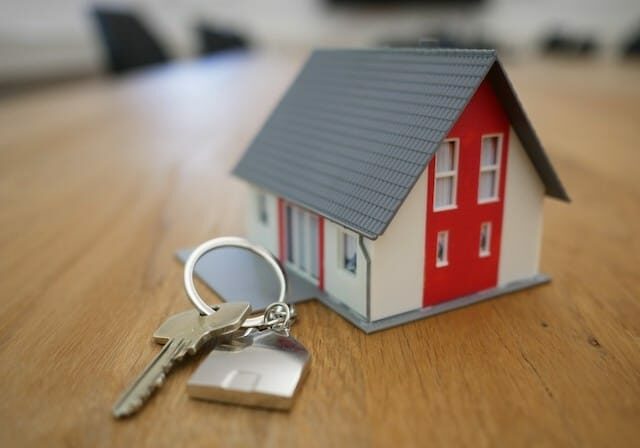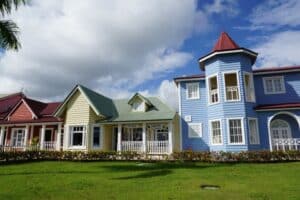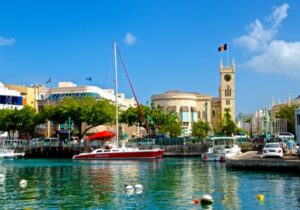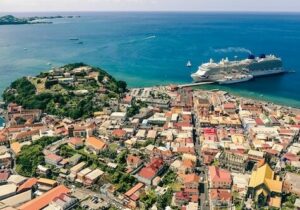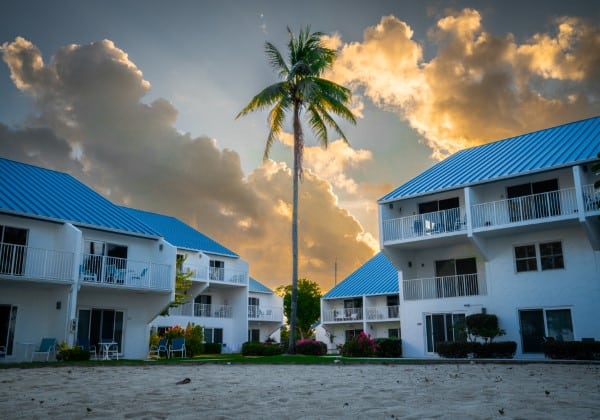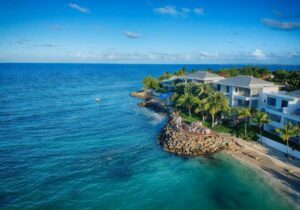As a foreign investor, you may wonder: Which is the best Caribbean island to buy property? The Caribbean’s real estate market is vibrant and poised for growth, with many foreign nationals seeking vacation homes, permanent relocation, and lucrative real estate investments.
Signs of progression have emerged from Statista’s prediction of a 4.49 percent growth rate in the Caribbean real estate market between 2024 and 2029, leading to a projected market value of $2.69 billion.
This guide answers all questions for investors seeking the best Caribbean islands for property investment, including insights into the real estate market, the benefits of investing in the region, and ways to purchase property there.
Key Considerations When Buying Caribbean Property
Stability: Economic and political stability is the cornerstone of investment potential and the main catalyst for growth in the real estate market. There is considerable variation in the stability of Caribbean islands, with some, like Haiti and Cuba, experiencing significant instability and economic hardship, whereas others, like Antigua and Barbuda and the Cayman Islands, have a proven track record of stability and linear economic growth.
Accessibility: A good location is particularly important when buying a Caribbean property to earn rental income. Access to regular flights is vital for consistent occupancy when establishing tourist accommodation. Check Google flights and the primary Caribbean airline carriers to see direct flight options to the island and their frequency. Likewise, long-term rental properties require considering access to local amenities such as supermarkets, schools, transportation links, and fitness centers.
Ease of investment: Buying property abroad may present challenges that may not be present when buying real estate in a home country. Most Caribbean countries that allow foreign property buyers to own real estate require licenses such as an Alien Landholding License (ALHL). Some Caribbean countries that offer citizenship by investment make it easier for foreigners to buy property by eliminating the ALHL requirement to purchase real estate.
Security: Safety and security assurance ensure you can live a peaceful life in your chosen Caribbean paradise. Besides safety and compliance with the rule of law, an island’s safety record affects real estate values, and the best Caribbean islands to buy a home or rental properties are safe and secure and provide stable property values.
Growth potential: Whether you’re looking to buy a luxury villa or affordable Caribbean real estate, growth potential will determine the property’s future value and profitability. Strong economic indicators include rising employment rates, infrastructure development, population growth, and foreign investment, signaling increasing demand for residential or commercial real estate.
The Ten Best Islands to Buy Caribbean Real Estate
1. Antigua and Barbuda
Antigua and Barbuda is a sister-island nation located in the Leeward Islands where the Atlantic Ocean and Caribbean Sea meet. Residential and commercial real estate is in demand, with many foreign buyers also interested in the island thanks to its citizenship by investment program. Most Antigua real estate buyers tend to be British and European, but interest among American investors has increased.
Despite significant demand, residential properties are in shorter supply, a factor that drives the price higher. Fortunately, Antigua and Barbuda remains a competitively priced market compared to some of its neighbors and its Caribbean real estate offers many advantages.
There are several developments planned (or already under construction), such as the redevelopment of Jolly Harbour, Barbuda Ocean Club, and high-end luxury holiday homes by Discovery Land. The average price per square meter for apartments is around $660, while oceanfront villas tend to cost around $1,250 per square meter.
Pros
- Developing quickly, providing a variety of investment opportunities
- Quality healthcare, with the Medical Benefit Scheme enabling residents to seek free primary medical treatment
- More affordable cost of living than the UK and the US
- Tourist visits have increased by 20,000 between January 2023 and January 2024
- Obtain citizenship by purchasing an investment property through the Antigua and Barbuda citizenship by investment program
Cons
- Prone to hurricanes
- Fewer direct flight routes to key flight hubs compared to other popular Caribbean islands
- Dependence on tourism
- Limited property market
2. The Bahamas
The Bahamas comprises over 3,000 Caribbean islands and is known for its business-friendly environment, thriving tourism sector, and natural scenery. Over the years, the government has implemented policies to boost the property market, such as low property tax and no capital gains tax.
The property market is characterized by high demand, and low supply, and buyers look to secure property to reside for at least four months annually. The tourism sector comprises 50 percent of GDP, providing excellent opportunities for those seeking the best Caribbean island for Airbnb investment to earn rental income.
Average real estate prices in the Bahamas vary. For example, a beachfront apartment or villa costs anywhere from $735 to $1,650 per square meter. It is worth noting that the Bahamas is relatively expensive to live, with average prices being around 30 percent higher than in the US.
Pros
- Children, the elderly, and pregnant women can benefit from free primary healthcare
- The Bahamas is a tax haven
- Thriving tourism ensures profitable property investments
- Students will find excellent education opportunities with nine Caribbean universities
Cons
- More prone to hurricane impact than other islands in the Caribbean
- More expensive than many Caribbean islands for real estate investment
- Dependence on tourism
3. Barbados
Barbados is a popular tourist destination, and properties tend to be more expensive than in other Caribbean islands. Prime property sits on the island’s west coast, thanks to beach access and amenities.
Barbados is a popular tourist destination, and properties are more expensive than other Caribbean islands. The island’s prime property sits on the west coast, thanks to beach access and amenities.
On this Caribbean island, you’ll find developments like Sandy Lane, which offers hotel rooms, suites, golf courses, and private villas. The island receives significant foreign investment and holds a long-standing appeal for international buyers.
Non-resident foreign buyers must obtain permission from the Central Bank to purchase real estate. The average price per square meter ranges from $550 to $1,400 for non-beachfront and beachfront villas, respectively. Apartments on the beachfront start at around $4,000 per square meter.
Pros
- The island boasts a warm climate, friendly locals, and beautiful beaches
- Barbados’ economy is stable
- Direct flights to the US, Canada, the UK, and other European countries
- Offers various tax incentives and investment opportunities
Cons
- Higher real estate costs than other islands
- Prone to bureaucratic delays when buying property
- Dependence on tourism
- No option to gain citizenship, and high cost to obtain residency through property investment
4. Cayman Islands
The Cayman Islands is famous for being an international tax haven and popular vacation destination, thanks to its pleasant climate and resort properties that offer true luxury. This British Overseas territory is an important financial and insurance center.
Despite global economic downturns, the Cayman Islands property market has remained buoyant, with prices expected to grow. This is due to greater demand than availability, particularly for beachfront condos. A vacation home in the Cayman Islands is a popular investment.
Furthermore, the nation has no annual property tax, income tax, or withholding tax, and stamp duty is levied at 7.5 percent of the purchase price. Several projects are in the pipeline to increase the supply, providing future opportunities.
The average price per square meter is $585 to $2,780, depending on the property type and its location in the Cayman Islands.
Pros
- Two private hospitals and healthcare is on par with international standards
- Property prices remain stable
- Residents of the Cayman Islands enjoy a luxurious lifestyle
- A tax haven with a stable economy
Cons
- One of the most expensive Caribbean islands to live in
- Has the Caribbean’s highest property prices
- Dependence on the offshore finance industry
- No option to gain citizenship, and high cost to obtain residency through property investment
5. Dominica
Dominica has gained a reputation as the best Caribbean island to buy rental property in 2024. In fact, many consider it the best Caribbean island to buy real estate due to the low cost of living and high quality of life.
The average price per square meter for Dominica real estate starts at $500, depending on the type of property and its location. You’ll need an Alien Landholding License to purchase prime real estate as a foreigner outside the country’s citizenship program.
Pros
- Boasts natural landscapes, spectacular views, and a welcoming local population
- No wealth, capital gains, or inheritance tax.
- As per an agreement between the Commonwealth Nations, Dominica nationals can pursue further education in the UK
- One of the most affordable Caribbean islands to live in
- Numerous eco-friendly developments that are in line with its climate resilience initiatives
- Caribbean real estate investments under the Dominica citizenship by investment program are a path to citizenship
Cons
- Prone to hurricanes
- Fewer direct flight routes to key flight hubs compared to other Caribbean destinations
- Dependence on tourism
- Citizenship program not as desirable as others in the Caribbean
6. Dominican Republic
A popular Caribbean tourist destination, the Dominican Republic offers some affordable property options. The economy has grown significantly in recent years thanks to tourism, agriculture, free-trade zones, and foreign investment in the country.
The country is politically stable and offers a stable real estate market where good rental yields are possible. The Global Property Guide lists the average price per square meter for property in the Dominican Republic at $2,328.
Pros
- Growing economy, offering various opportunities for investment in affordable real estate
- Attracted over 10 million tourists in 2023, more than any other Caribbean country
- Cost of living is more affordable than in the United States and European countries
Cons
- Document cases of property title issues, including fraudulent claims
- Less economically than other islands
- Higher crime rate than other Caribbean countries
- Prone to hurricanes
7. Grenada
Grenada is known for its spice exports and unique tourism industry. The introduction of the Digital Nomad Visa alongside the citizenship by investment program has led to Grenada real estate presenting a strong local rental market and a sales market that has performed well.
Overseas buyers look mainly for retirement or vacation homes, and projects are in the pipeline to develop more accommodation to supply growing demand. Square meter property prices in sought-after towns start at $1,000 to $2,500, and the average annual rental yield in Grenada sits at around 4.3 percent.
Pros
- Grenada’s healthcare system is considered one of the Caribbean’s best.
- A strong pipeline of real estate projects is underway, which can provide further opportunities for real estate investments.
- Investors can gain Grenada citizenship by investment through purchasing real estate.
Cons
- Prone to hurricanes
- Dependence on tourism
- Higher cost to obtain citizenship through real estate investing than other Caribbean programs
8. Jamaica
Jamaica, along with Barbados, is one of the more expensive places to purchase property in the Caribbean. The average price per square meter starts at around $2,000. With increased access, including the new Miami to Ocho Rios flight route introduced by American Airlines, tourism is set to increase.
While real estate investing in Jamaica is expensive, it is profitable. Additionally, Jamaica places no restrictions on foreign ownership.
Pros
- Offers plenty of natural wonders, including thermal springs, coral reefs, mountains, and beaches
- Foreign investment has increased, including the modernization of Ian Fleming International Airport in Ocho Rios to receive international flights
- The tropical climate and year-round sunshine attract many tourists, digital nomads, retirees, and expat families
Cons
- Frequent negative travel advisories due to safety
- Dependence on tourism
- No option to obtain residency through real estate investment
9. St Kitts and Nevis
Home to beautiful beaches, a tropical climate, and picturesque mountains, St Kitts and Nevis is considered the best island to buy property in the Caribbean this year. With its thriving tourism industry, the country continues to be popular among investors, holidaymakers, and retirees.
The government has taken steps to revitalize the real estate market and stimulate tourism through foreign investment. This included an investment from Troy Property Investment Limited in 2024 to build a new hotel and water park alongside the island, which became a port destination for the world’s largest cruise ship, Icon of the Seas, in January 2024.
There are five-star resorts, such as Belle Mont Farm and Park Hyatt, luxury beachfront villas, eco-resorts, high-class residential properties, and profitable commercial buildings.
Average St Kitts and Nevis real estate prices can range anywhere from $4,000 to $10,000 per square meter, depending on the property type and amenities. Annual rental yield sits at four to five percent.
Pros
- Rental income comes from various sources, including international students attending the country’s renowned medical schools
- St Kitts and Nevis has favorable tax policies, with no income, capital gains, gift, wealth, or inheritance taxes
- Investing in real estate is a path to St Kitts and Nevis citizenship by investment
Cons
- More expensive than other Caribbean CBI countries
- Dependence on tourism
- Over double the minimum investment required for citizenship by real estate investment compared to other countries when purchasing a single private home
10. St Lucia
Like much of the Caribbean, St Lucia’s economy heavily depends on tourism, making up 65 percent of its GDP. The government attracts tourists and foreign investment through programs such as citizenship by investment and the ‘Live It’ program, which allows tourists to stay on the island for up to a year on a multi-entry visa.
Like most Caribbean nations, property costs in St Lucia are influenced by location, size, and amenities. A property like a luxury condo in Sugar Beach Luxury Residences, opposite the Pitons UNESCO World Heritage Site, is relatively expensive. Residential homes on the beachfront can range anywhere from $2.5 million to $8.5 million. The average price per square meter for St Lucia real estate is $660 to $1,890.
Pros
- St Lucia residents benefit from the National Healthcare Scheme
- There’s no tax on foreign income, capital gains, or inheritance
- St Lucia’s Ministry of Tourism announced a four percent growth in tourism from January to May 2024 compared to the same period in the previous year
- The St Lucia citizenship by investment program allows property investors to obtain dual citizenship
Cons
- Vulnerable to natural disasters
- Less tourism than in other Caribbean islands
- Few approved real estate projects than other Easter Caribbean States for obtaining citizenship by investment
Why invest in Caribbean real estate?
The Caribbean region, comprising numerous islands and territories and the Caribbean Sea, attracts investors and homebuyers from across the globe due to its unmatched quality of life. From luxury villas to urban condos, investing in the Caribbean real estate market offers various options.
In 2024, the Caribbean real estate market has evolved to the changing preferences of both local and international buyers, leading to a predicted increase in its market value of almost from $2.16 trillion in 2024 to $2.69 trillion by 2029, according to Statista.
Several factors have shaped the Caribbean real estate landscape. Firstly, the ongoing global shifts in remote work and lifestyle priorities have driven increased demand for second homes and investment properties, making the Caribbean even more attractive. The region’s ability to offer a blend of natural beauty, a welcoming culture, and modern amenities positions it as an ideal destination for a better work-life balance or tourism, resulting in a profitable annual rental yield for investors.
Furthermore, sustainability and environmental consciousness are pivotal considerations in real estate investment decisions, and the Caribbean is no exception.
Sustainable development, eco-friendly architecture, and initiatives to protect the region’s pristine ecosystems are prominent within the market. As a result, buyers look for second homes and rental properties that not only offer exceptional views but align with their environmental values.
Caribbean governments recognize the potential of real estate as a driver of economic growth and stimulate its progress by implementing various incentives to attract foreign investment, from tax breaks to citizenship by investment programs.
These policies have contributed to expanding the Caribbean property market, drawing attention from high-net-worth individuals, entrepreneurs, and real estate investors alike.
Why invest in Caribbean real estate?
The Caribbean region, comprising numerous islands and territories and the Caribbean Sea, attracts investors and homebuyers from across the globe due to its unmatched quality of life. From luxury villas to urban condos, investing in the Caribbean real estate market offers various options.
Growing tourism
In 2024, the Caribbean real estate market has evolved to the changing preferences of both local and international buyers, leading to a predicted increase in its market value of almost from $2.16 trillion in 2024 to $2.69 trillion by 2029, according to Statista.
Relocation and remote work
Several factors have shaped the Caribbean real estate landscape. Firstly, the ongoing global shifts in remote work and lifestyle priorities have driven increased demand for second homes and investment properties, making the Caribbean even more attractive. The region’s ability to offer a blend of natural beauty, a welcoming culture, and modern amenities positions it as an ideal destination for a better work-life balance or tourism, resulting in a profitable annual rental yield for investors.
Sustainable expansion
Sustainability and environmental consciousness are pivotal considerations in real estate investment decisions, and the Caribbean is no exception. Sustainable development, eco-friendly architecture, and initiatives to protect the region’s pristine ecosystems are prominent within the market. As a result, buyers look for second homes and rental properties that not only offer exceptional views but align with their environmental values.
Favorable taxes
Caribbean governments recognize the potential of real estate as a driver of economic growth and stimulate its progress by implementing various incentives to attract foreign investment, including no income taxes on rental income or inheritance, wealth, or capital gains taxes.
Citizenship by investment
Five Caribbean countries offer foreign property buyers the opportunity to obtain Caribbean citizenship through real estate investing, with the lowest investment starting from $200,000. These countries are Antigua and Barbuda, Dominica, Grenada, St Kitts and Nevis, and St Lucia.
Through a foreign direct investment in approved real estate projects, such as luxury properties and vacation rentals, or an approved private home, investors can qualify for Caribbean citizenship by investment programs and obtain Caribbean passports for themselves and their family.
Average Price of Caribbean Real Estate Per Square Meter
The average Caribbean property value per square meter in the following countries is based on available data from Numbeo.
Country | Average Price Per M2 |
Cayman Islands | $10,300 |
St Kitts and Nevis | $4,500 |
Barbados | $3,500 |
Aruba | $3,300 |
British Virgin Islands | $3,000 |
Trinidad and Tobago | $2,700 |
Jamaica | $2,500 |
The Bahamas | $2,200 |
Puerto Rico | $1,750 |
Dominican Republic | $1,300 |
Belize | $1,200 |
Key Takeaways about the Best Islands in the Caribbean to Buy Property
- Path to citizenship: Buying approved property in specific Caribbean countries, including Dominica, Grenada, St Kitts and Nevis, Antigua and Barbuda, and St Lucia, is a path to citizenship and a Caribbean passport.
- Minimum investment: The qualified value of real estate purchases to obtain citizenship is $200,000 to $400,000.
- Property prices: Caribbean property prices vary from country to country, from as little as $500 per square meter in cheap, low-demand locations to $3,000 per square meter or more for high-demand property with direct beach access.
- Market stability: Though Haiti has affordable property options, political instability causes fluctuations in its property market. Countries like the Cayman Islands and St Kitts and Nevis have stable property markets owing to political stability and favorable taxes for investors.

Frequently Asked Questions about the Best Countries to Buy Property in the Caribbean
What is the cheapest Caribbean country to buy real estate in?
The Dominican Republic is one of the most affordable Caribbean islands to purchase property. Another relatively affordable destination is St Vincent and the Grenadines. These islands offer good value for money and attract many investors. While property is more affordable, these countries do not offer residency or citizenship through real estate investments.
What is the safest Caribbean island to buy property?
Grenada is generally considered one of the safest Caribbean countries for property investment. Other safe destinations in the Caribbean include Antigua and Barbuda, Anguilla, the British Virgin Islands, the Cayman Islands, and Montserrat.
Where is the best place for Americans to buy in the Caribbean?
Antigua and Barbuda, Dominica, Grenada, St Kitts and Nevis, and St Lucia are excellent options for Americans interested in the best place to buy a beach house in the Caribbean and other property. These islands offer quick and easy ways for foreign investors and their families to obtain citizenship by investing in real estate.
Where is the best place to buy condos in the Caribbean?
The Dominican Republic is an excellent place to buy condos within walking distance of white sand beaches. If you have the means, places like the Turks and Caicos Islands, Cayman Islands, Bahamas, Barbados, and Antigua and Barbuda have a selection of condos offering luxury living.
How can I finance a property purchase in the Caribbean?
You can obtain a mortgage to purchase real estate on a Caribbean island. The maximum loan-to-value available is generally between 70 percent and 75 percent of the purchase price or valuation (whichever is the lower).
Can foreigners own beachfront property in the Caribbean?
Foreigners can own beach houses in the top Caribbean islands. The Bahamas and the Cayman Islands require foreigners to obtain government approval before making a Caribbean real estate investment.
Can Americans buy property in Aruba?
The Aruba government allows foreigners, including Americans, to buy property on the island. While there is no residency by real estate investment program, foreign buyers face no restrictions when acquiring real estate.
What are the best Caribbean islands for purchasing property?
The best Caribbean island to buy property depend on individual needs. If you’re looking for affordability, the cheapest Caribbean islands for real estate investments are St Vincent and the Grenadines and the Dominican Republic.
If you’re seeking second citizenship, the best island to buy property in the Caribbean to obtain citizenship is either Antigua and Barbuda, Dominica, Grenada, St Kitts and Nevis, or St Lucia. If you’re looking for upscale property, the best places to find luxury real estate include the Bahamas, the US Virgin Islands, and the British Virgin Islands.

